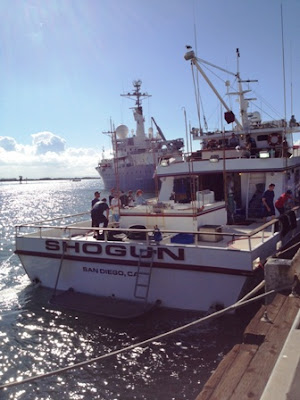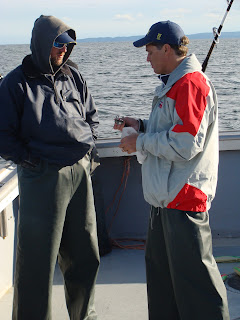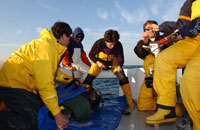Here is an angler's perspective from TAG supporter and bluefin enthusiast, Keith Brandner (Tenafly, New Jersey) regarding his recent experience angling for giant bluefin in Nova Scotia, Canada.
An Angler’s Perspective – Nova Scotia, Canada
I recently spent three days up in Antigonish,
Nova Scotia, trying to catch a giant bluefin tuna. I had never been in Canada,
let alone off in a remote town in Nova Scotia, so I had no idea what to
expect. All I had to base it off of was
the volumes of stories from Zane Grey from back in the 70s, magazine articles,
and the crazy reports from the captain. I cannot even express how many text
messages and emails I received saying: “Hammered ‘em again today, buddy! After
we released our fish we sat there and just hand fed them for the rest day…Man
it doesn’t get old!” Needless to say, I was very excited.
 |
| Figure 1: tuna under the boat! |
The ride out to the fishing grounds does not
give much chance for the anticipation to build. As a Northeast canyon
fisherman, I am used to 3+ hour motors out to the fishing grounds, so when the
engines stopped just 15 minutes after they had roared to life, I could not help
wonder if something was wrong. But nothing was wrong. In fact, everything was
perfect! My nervousness about whether the fish had left between the captain’s
last trip and this did not last very long – after about 30 seconds of throwing
chunked-up herring into the wind-chopped, green water, a flash from below
signaled that they had arrived.
I will remember my first glimpse of a giant
bluefin tuna for the rest of my life. After years of hearing that these fish
were “the size of a Volkswagen,” I learn that it is not an exaggeration. The
flash from below, though moving very fast, was impossible to miss. The massive
tuna, circling underneath the boat, was taking swipes at the herring chunks we
were tossing overboard and slowing moving up the water column until it was
crushing the chunks as they hit the surface of the water. It was an incredible
sight.
 |
| Figure 2: The author fighting a tuna as the sun goes down! |
When the captain finally asked if I was ready
to catch one, it almost caught me off-guard. I was having so much fun just
watching these fish swim, eating our bait next to the boat, that the thought of
leaving it behind was almost sad. After a few more tosses, we decided it was
time.
 |
| Figure 3: What an incredible fish! |
It only took a few seconds before one of the
huge fish took the bait and promptly took half of the spool with it. Even 60 pounds of drag could not tame this
fish. After about 45 minutes of battle, the fish finally rolled next to the
boat. I found that one really cannot appreciate the truly incredible size of
these fish until one gets to see them boat-side, clear as day. I could not
believe it – I put my hand on the gill plate of the fish and found that my hand
was just larger than the eye of the fish.
 |
| Figure 4: I guess he's ready to go! |
After some photos, the fish gave a
strong kick to let us know that he was ready to be released. As it swam away, I
could not help but wonder what was next for it. Would it continue feeding on
the bank, or would it begin its journey down to the Gulf of Mexico to begin
breeding? Or would it make the transatlantic journey to the Mediterranean Sea?
I guess it is the wonder, intrigue, and amazement that keeps us coming back day
after day and year after year. The next few days were just as good as the
first. The fish continued to put on a show and just like the captain had said,
it never got old. I cannot wait to go back again next year!




































.jpg)















